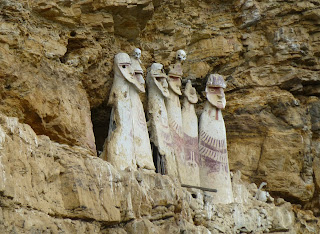Not at all in the order of the trip, but I've wanted to see a sword-billed hummingbird for many years, so this has to be the first photo for this post! My top target for the trip was actually a different hummingbird, the marvellous spatuletail, but as expected I did not get to see it - after all, this was not a birding trip, but primarily one focused on archaeological sites. But I was very happy to see the sword-billed, and that it sat still for long enough to enable me to get a focused photo!
 I did see a number of good new bird species, including the endemic Tumbes Tyrant, White-winged Guan, and Koepcke's Screech-Owl - the first two, with a number of other species, at the Chaparrí reserve. This was a wonderfully remote place with rustic yet comfortable cabins in the middle of a low scrub forest (I slept so well!), great food and very comfortable hammocks hanging in the porches. I would have liked to spend another day there, in a reserve which had more than just birds. We didn't see any of the wild spectacled bears, only those in the rescue and rehabilitation centre, but a fox was cheekily walking around near the kitchen.
I did see a number of good new bird species, including the endemic Tumbes Tyrant, White-winged Guan, and Koepcke's Screech-Owl - the first two, with a number of other species, at the Chaparrí reserve. This was a wonderfully remote place with rustic yet comfortable cabins in the middle of a low scrub forest (I slept so well!), great food and very comfortable hammocks hanging in the porches. I would have liked to spend another day there, in a reserve which had more than just birds. We didn't see any of the wild spectacled bears, only those in the rescue and rehabilitation centre, but a fox was cheekily walking around near the kitchen. We drove through the arid coastal desert and up into (and over) the Andes, much of which was also very arid with little vegetation except for cacti. There was the odd hummingbird - and some tarantulas in their web-nests beside the road - and one just sitting on the side of the road. Like many people I find these spiders both fascinating and repellent at the same time. We briefly passed through cloud forest, and also just into the Amazonian region where the Gocta Falls were located. 'Discovered' less than a decade ago, these are amongst the highest falls in the world, and the walk towards them, up and down hills between coffee and sugar cane crops and finally through a small area of virgin rainforest, was hard but very enjoyable. This picture to the left is a distant view from early on in the walk, but I was one of those who succeeded in reaching the base of the falls.
We drove through the arid coastal desert and up into (and over) the Andes, much of which was also very arid with little vegetation except for cacti. There was the odd hummingbird - and some tarantulas in their web-nests beside the road - and one just sitting on the side of the road. Like many people I find these spiders both fascinating and repellent at the same time. We briefly passed through cloud forest, and also just into the Amazonian region where the Gocta Falls were located. 'Discovered' less than a decade ago, these are amongst the highest falls in the world, and the walk towards them, up and down hills between coffee and sugar cane crops and finally through a small area of virgin rainforest, was hard but very enjoyable. This picture to the left is a distant view from early on in the walk, but I was one of those who succeeded in reaching the base of the falls.When we got there our guide took a look in the rubbish bin, and didn't seem very surprised to find an oppossum in there...
The other part of the trip was the chance to see the Raymillacta festival in Chachapoyas. This has been going for some twenty years, with groups coming from quite some distance to take part. Rather like a harvest festival really, many of the villages or associations showed off the produce from their area, either through their costumes or through samples of food and drink being carried through the streets. Many were throwing or giving samples to the crowd and I brought home a little bag of organic coffee as well as having drunk various local corn and spirit drinks. There was a great deal of music too, from brass bands to traditional pipes and drums, The only part I didn't like were the headdresses of two groups which included real toucan bills.






